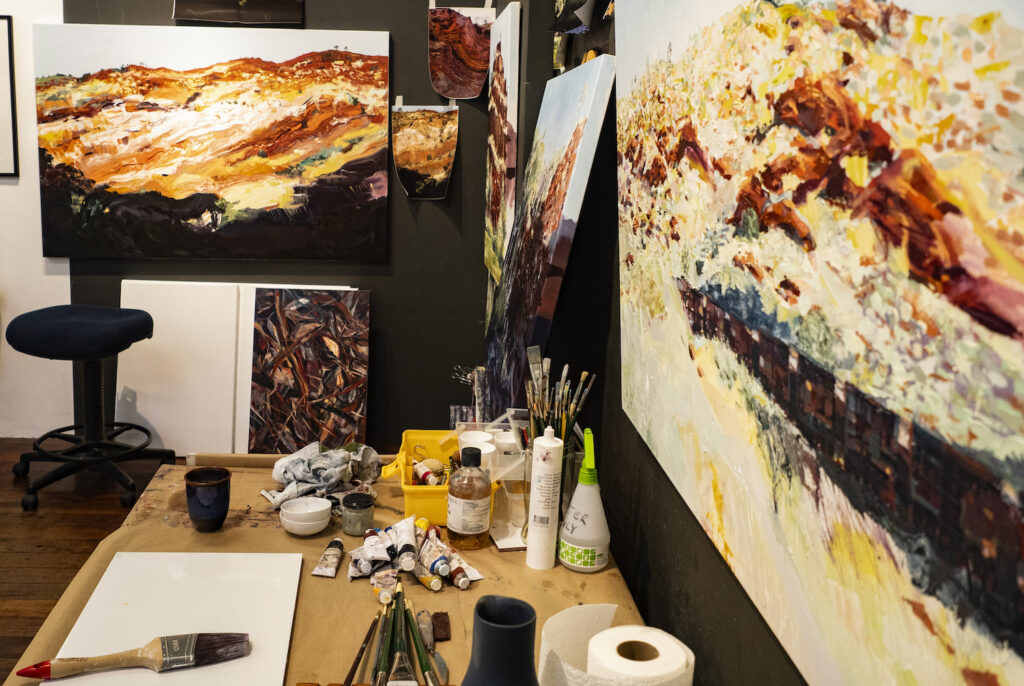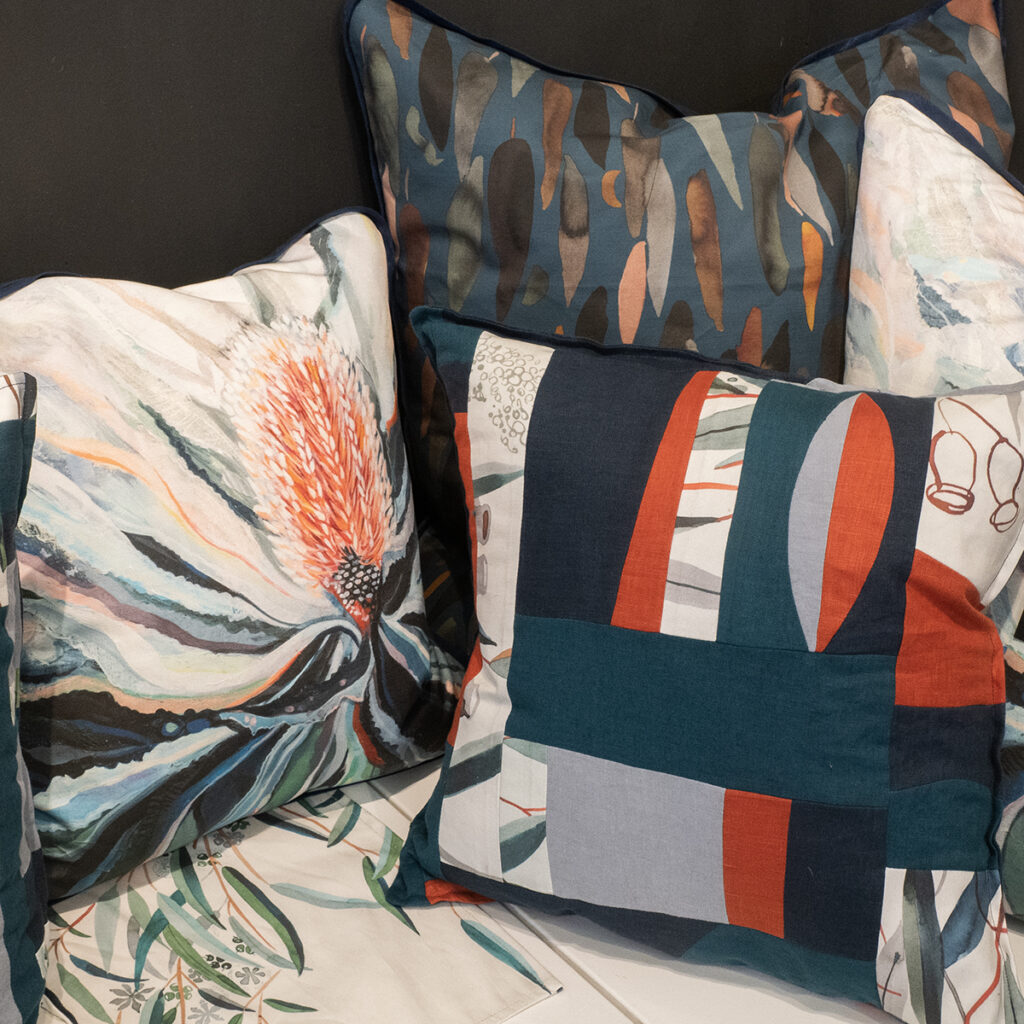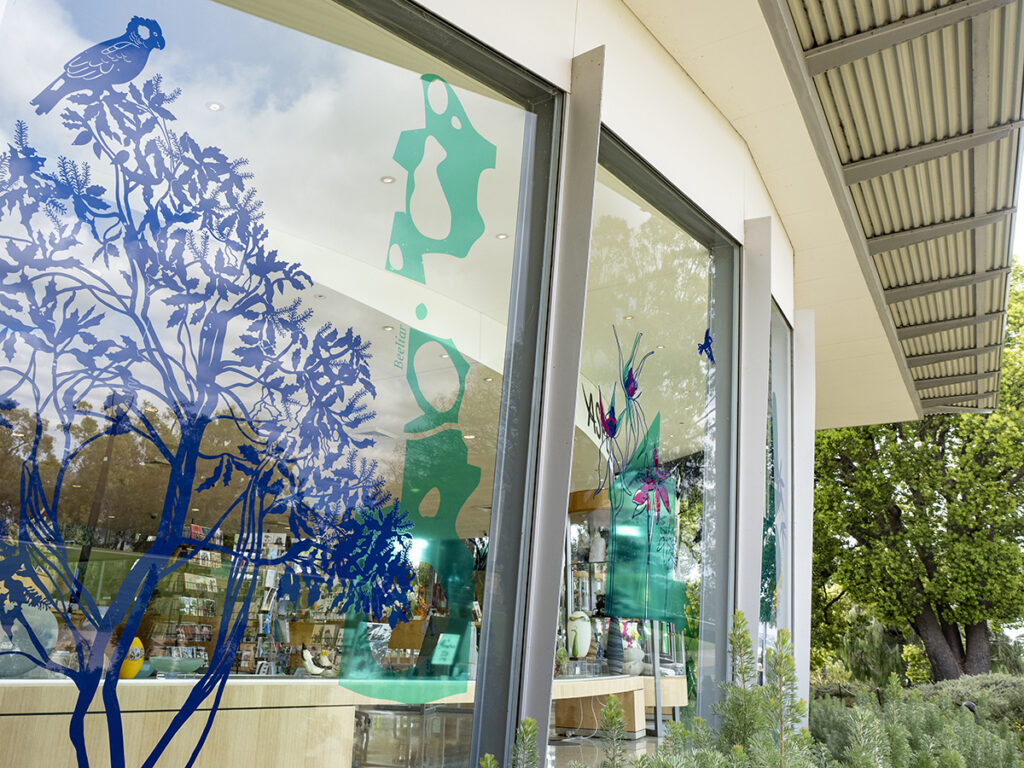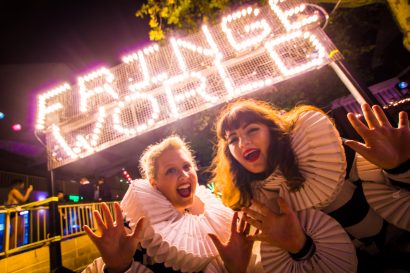From the plunging depths of the gorges to the rich colours of the rocks, the intense palette and texture of Karijini’s landscape inspired Jane Coffey’s latest exhibition.
Capturing the colour of Karijini
9 August 2023
- Reading time • 10 minutesVisual Art
More like this
- A walk with Tina Stefanou
- A blaze of glorious people
- Diving into the gothic world of Erin Coates
If you’ve paid a visit to Aspects of Kings Park you’ll be familiar with artist and designer Jane Coffey’s work, which depicts the delicate and elegant silhouettes of Western Australia’s native flora and fauna.
Since 2011 Coffey has created annual art installations on the windows of the Kings Park gift shop. Using layers of transparent, printed and metallic cut vinyl, adhered to the panes, she plays with light, shadow and colour.

Inside the shop you’ll see a selection of souvenirs designed by Coffey, but you’ll need to head to her North Perth gallery and store to realise the scope of her work. At Future Shelter you’ll find Coffey’s oil paintings, watercolours and prints, as well as the full range of her signature homewares, stationery and accessories.
This August you’ll also encounter Coffey’s latest exhibition of work. Entitled Karijini: Banded Iron, this collection of oil paintings sees Coffey turn her eye to the colour, rock formations and reflective light of one of WA’s most dramatic national parks.
A long-term customer of Future Shelter, Nina Levy was delighted to chat to Coffey ahead of the exhibition opening.
Nina Levy: Jane, you’re originally from the UK and trained at London’s Royal College of Art. What brought you to Perth?
Jane Coffey: Love brought me to Perth from London. I met my husband Adam in the UK and he is from Perth. We decided to move here to “see if I liked it”.
I did like it (he fed me lots of prawns and great food which I’m easily swayed by). I feel very at home here. Perth may not have the grand museums of London, but it gives me more time and space to create art.
NL: Your work is so strongly tied to Western Australia. Have you always been inspired by place, or is it this place in particular?
JC: I feel strongly that inspiration should come from your surroundings.
I was trained to draw from life rather than copying from books so all my colours and mark making come from directly observing the subject I’m interested in. This could be industrial if you are in Port Hedland, or natural landscape if you are are in Karijini.
I can find even the smallest details inspiring, I painted the road signs and paving into an artwork based around North Perth because that is the reality of what is there. It’s not just about painting the traditional heritage buildings, but also the signage, road surface and all the infrastructure that makes up a place.

NL: And what drew you to Karijini?
JC: With Karijini, I was struck by the vast scale of the landscape. It is hard to comprehend the landscape in one sitting and it’s often only when you notice the size of a distant tree that you realise how deep the gorges are. When looking from a viewpoint you have to physically move your head from left to right to take in the whole scene.
It is also a place of extremes. The bright light reflected off the spinifex during the heat of the day contrasts with deep shadows in the gorges and rich colours of the rocks.
NL: Your artistic practice is broad, encompassing large-scale sculpture, paintings, murals, illustration and textiles. How do you choose which medium to use for a work?
JC: The medium is usually dictated by where the artwork will finally be presented.
For my painting practice, oil paint suits my style and rhythm of work. I have children and my own store so I’m frequently interrupted by other responsibilities. Oil paint is very forgiving and dries slowly, your palette can last a few days at a time. Acrylic doesn’t let you do this as its dries quickly.

Oil colours can be much denser and more opaque which I prefer. The colours of Karijini are intense! I used a palette knife and applied the paint more loosely and quite thick so that I could emulate the blended and layered rocks. The chaotic landscape dictated a more chaotic style of painting.
For work that is applied to products or printed murals, ink drawing is the most flexible medium to start with. Some works have to be scanned easily and so high contrast is better.
Once scanned I apply colour using the computer. This is how a lot of my limited edition prints are created.
Ink allows you to be more spontaneous and take more risks because you are only focusing on mark making and drawing onto paper which is less pressure than canvas. I am always trying to get this same feeling of spontaneity into my oil painting. I think I managed to capture this in the Karijini works.
NL: Anyone who has had the pleasure of visiting your gallery shop Future Shelter will know that you are both an artist and a designer – alongside your paintings and prints, Future Shelter sells all sorts of lovely homewares, stationery and fashion accessories. What inspired you to branch out into designing?
JC: My engineering husband is also full time in the business has a great passion for local manufacturing. So it made sense to design illustrations and surface patterns for products that he can then make. Our workshop is kitted out with all sorts of machines and fancy printers. We very proud that we are both inspired by local and make locally – it’s not always easy!
NL: You’ve also worked as a commercial illustrator for over 20 years, for clients that range from the Museum of Modern Art in New Work, to Kings Park Botanic Gardens, to Marks and Spencer in the UK. What’s the most interesting commercial job you’ve ever done?

JC: It has to be working with Kings Park. I’m just about to install my twelfth mural into the windows of Aspects of Kings Park.
There is no doubt that what started as a commercial interest has developed into a full-blown obsession with all the flora and fauna of WA. Yes, including snakes and scorpions. I’d secretly like to do a spider exhibition but I’m not sure how well this would go down.
NL: Tell me about your new exhibition Karijini: Banded Iron. What led you to paint Karijini?
JC: We had family living in Karratha at the time. We decided to do a road trip with the camper trailer and travelled from Karratha to Millstream then continued to Karijini and spent a couple of weeks walking through the gorges, drawing and taking photos. I loved the remote, extreme landscape. I think all artists can’t help be inspired by Karijini’s dramatic landscape.
It’s taken me a while to feel more confident to create larger works. These are the largest works I’ve created and I’ve loved painting on canvas bigger than myself.
Karijini: Banded Iron opens 20 August and runs until 3 September, at Future Shelter.
Pictured top: A detail from Jane Coffey’s ‘Karajini Grasslands’. Photo: supplied
Like what you're reading? Support Seesaw.






